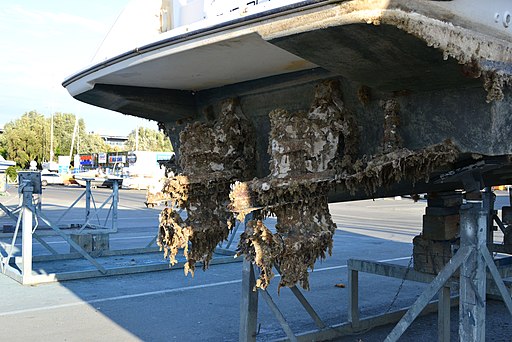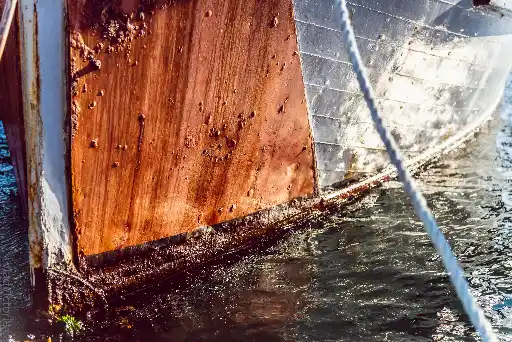7 antifouling solutions to protect your boat’s hull
Boat hulls are constantly exposed to marine conditions and the growth of marine organisms that can colonize them. These weeds, slimy animals and even shellfish can affect boat speed and handling, and can even damage the hull in the long term. Protecting the hull is crucial to the durability of your boat, as well as keeping its performance up, reducing maintenance costs and even saving on fuel. There are many ways to protect your hull. Let’s take a look at seven of them:
- traditional antifouling paints,
- copper-based antifouling paints,
- hull varnishes,
- smooth non-stick coatings,
- fiber-based non-stick coatings,
- ultrasonic antifouling, and
- hull protection covers.
Each of these solutions offers a unique approach to protecting your hull, so we’ll focus on the benefits and drawbacks of each. You can then choose the one that best suits your boat and your needs.
Solution 1: Conventional biocide-based antifouling paints
Anti-fouling paint, or antifoul, is the traditional coating that has been applied for decades on boats to prevent the growth of weed, shellfish and other marine life. It is made up of a biocide and a non-stick agent that prevent marine organisms from attaching to the hull and kills those that do. These paints come as a hard or erodible matrix, to be chosen according to the boat’s speed, anchorage location, cruising area, etc.
Antifoul is so widely used that its advantages have long been considered numerous and interesting. Antifouling paint prevents biofouling, thus facilitating maintenance. It also maintains boat performance and reduces drag. This increases boat performance and durability, as long as new coats are applied regularly.
However, antifouling paint is a biocidal chemical nonetheless. It is therefore highly polluting for the marine environment. But it’s not just harmful to marine biodiversity! It also presents risks to human health, when applied and especially when stripped or sanded. Secondly, its use is now subject to regulatory constraints, such as not being able to scrub the hull afloat, due to its toxicity for the environment. Its lifespan is also limited to a maximum of 1 to 2 years. If the boat is used in waters particularly prone to marine growth, it may have to be hauled out twice a year, with the associated coasts.
Here is a selection of the most popular antifouling paint brands: Altex, Boero, Hempel, International, Nautix, Pettit, Seatec, Veneziani…

Photo Jean-Pierre Bazard, Wikimedia Commons
Solution 2: Copper-based paints
Copper paints are paints that incorporate metallic copper particles (ie. not in the form of ions). Copper is a material that prevents biofouling, the growth of marine organisms on a boat’s hull. Historically, the wooden hulls of ships of yesteryear were covered with copper plates to prevent shipworms from causing the wood to rot!
One of the main advantages of copper-based antifouling paints is their long-term effectiveness. Compared with traditional biocidal paints, which have to be applied every year, copper paints can last for several years, sometimes up to 10, considerably reducing the cost and hassle of hull maintenance. What’s more, copper antifouling boat hull paints are somewhat more environmentally friendly than biocidal paints. Copper particles are considered less harmful to the environment, as they are more easily degradable.
The main deterrent to this solution is its price per treatment. It amounts to a real investment compared to antifouling paints. Furthermore, copper is not suitable for aluminum hulls, due to the corrosion it causes. Even on other types of boat, it can cause slight corrosion on metal propellers and rudders, as well as on unprotected wooden hulls. If you opt for copper paint, you’ll need to pay particular attention to anode wear. Finally, copper is harmful to the environment. In the Baltic Sea, 40% of copper pollution is attributable to hull paints!
In this category, we can mention Coppercoat, a brand of copper-based antifouling paint relatively popular with boat owners. The paint is composed of pure copper particles suspended in an epoxy resin.
Solution 3: Hull varnishes
Hull protection varnish is a less common option than traditional antifouling paints. It protects boat hulls from fouling by seaweed and shellfish, as well as from corrosion. Made from water-resistant polymers , the varnish creates a protective barrier between the hull and marine organisms.
Unlike previous options, the varnish contains no chemical compounds harmful to the environment, nor metals such as copper, making it a more environmentally-friendly option.
However, it is important to note that varnish is not as effective as antifouling paints in preventing hull fouling. Consequently, varnish requires regular maintenance to maintain its effectiveness, including regular scrubing of the hull and periodic new coats of varnish.
To clean the hull, use fresh water and a mild detergent, avoiding abrasive detergents or acid-based cleaners which could damage the varnish. The use of a soft brush is also recommended to avoid scratching the varnish surface. Power tools such as polishers or high-pressure cleaners should be avoided, as they could damage the varnish. Finally, it is essential to regularly monitor the hull for any signs of damage or deterioration of the varnish.
Among those offering varnishes is Eco’Prisme and its graphene-based Parafouling.

Solution 4: Smooth non-stick coating
Smooth films are an alternative to antifouling paint for protecting boat hulls. This technique involves applying a silicone adhesive film to the hull surface. The lack of adherence prevents marine organisms from binding to it.
The main advantage of this solution is that it contains no toxic substances harmful to the environment. What’s more, it saves water and energy when the boat is hauled out for maintenance. Last but not least, it lasts longer than conventional antifouling paint, saving you money on hull protection. In fact, the non-stick coating only needs to be renewed every 5 years, unlike conventional antifouling, which has to be reapplied on average every year. In contrast to biocidal antifouling paints, underwater scrubbing is generally allowed. It is done with a simple brush.
However, this solution also has its drawbacks. Firstly, adhesive film is more expensive to buy than traditional antifouling paint, which can be a deterrent for some boat owners. What’s more, it can be difficult to apply correctly, and requires a certain amount of expertise. Moreover, when it comes to removal, it obviously generates some plastic waste. Finally, its effectiveness may be limited in areas with a high concentration of marine organisms, requiring more regular monitoring of hull condition.
Solutions on the market include Uniflow’s Flow Silikon and Mactac’s MacGlide.
Solution 5: Fiber-based non-stick coatings
These films are another eco-friendly coating solution, but this time, unlike other non-stick coatings, they hold up better in areas with high concentrations of marine organisms. The secret behind these carpet-like adhesives is their special technology, which reproduces the spines of sea urchins. They are also dirt-repellent, durable and offer high performance. Their manufacturer points to a design which, they claim, protects vessels’ hulls from unwanted marine organisms while enhancing boat performance.
One of the main strengths of these adhesives is their positive ecological impact, since they contain no toxic products that can be harmful to the marine environment. They are durable and UV-resistant, which means they last longer than traditional paints. And it’s easy to brush off marine growth whether afloat by diving or with a high-pressure washer. Some harbors are even beginning to allow the use of careening slips to boats which have such coatings. Now that’s a money-saver!
However, they also have a few drawbacks. Their upfront cost is high compared with traditional paints, although they can save money over time. In addition, their application requires the intervention of a professional, and drying time can be lengthy. According to our research, color is also limited, and it can be difficult to remove if necessary.
Among the leading products on the market is the Finsulate range.

Photo Nick Hobgood, Wikimedia Commons
Solution 6: Ultrasounds
Let’s talk about ultrasonic antifouling. This is a sonar technology that uses sound waves to control the growth of marine organisms on boat hulls.
This technology is ecological, as it is non-toxic for the marine environment, economical in the long term, easy to install and compatible with most types of hull (except those that are too deep).
However, it can be less effective for stationary boats, requires a power supply to operate, has a higher initial cost than traditional antifouling, and may not be sufficiently effective in specific geographical areas or weather conditions. It may also require regular maintenance, and may not be as effective as traditional antifouling for deep-draft boats. What’s more, when you live aboard or moor your boat in a marina with inhabited boats, this solution can produce noise nuisance, audible or otherwise. Finally, given the importance of ultrasound for a whole range of marine fauna, we might wonder whether this solution is really as environmentally friendly as advertized.
We’ve been talking about this technology for decades, but today it’s well and truly on the market, notably from Sonihull and Hasytec.
Solution 7: Protective covers
This last solution in our comparison protects the boat’s hull from fouling, preventing the proliferation of micro-organisms thanks to the absence of light.
One of its main advantages is its cost effectiveness. In fact, this solution avoids the costly annual refit that can be so costly for boat owners. What’s more, the cover is 100% recyclable, eliminating the need for toxic antifouling agents that pollute the marine ecosystem. It therefore reduces your boat’s ecological footprint.
The cover is relatively easy to use and/or transport. It lasts for around ten years, which is more practical and less costly than having to reapply antifouling every year. Despite all these advantages, it should be noted that some hull-shapes might be more suitable than others for this type of cover. Although there have been examples for pretty much any type of leisure boats, they essentially need to be custom-made. So it can be more expensive to purchase than other hull protection solutions.
Furthermore, the hull does not foul but the cover fouls in its stead. Hence, cleaning the cover does remain a chore. Last but not least, the boat needs to be handled every time it leaves and arrives in port, so that it’s well protected when it stops sailing.
Innovative protective covers are available from K-Ren or ProtecMarineNC, for example.

Wrapping up
We have seen classic antifouling is effective in preventing fouling by marine organisms on boat hulls. But it has harmful consequences for the marine environment. That’s why more and more eco-friendly and sustainablealternatives are emerging, such as biocide-free antifouling paints, smooth non-stick coatings, fiber films, ultrasonic antifoulings and protective covers. Each of these solutions has its pros and cons.
Armed with these tips, you can now choose the most appropriate method to best care for your boat. Alternative solutions are often more expensive to purchase than traditional annual antifouling, but they often offer more effective protection, last longer and are more respectful of the marine environment. So it’s important to think long-term to protect the hulls of our boats while preserving our fragile oceans.
Subscribe to our monthly newsletter to receive tips on keeping your boat in good health.
